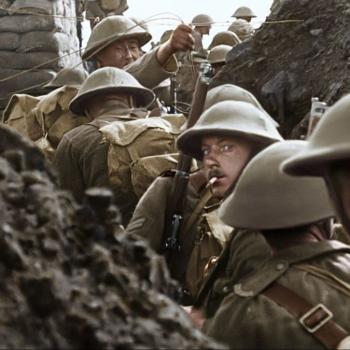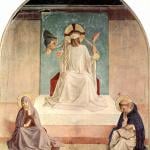 The most famous and beloved story of St George is that of his slaying of the dragon. In it we are told that near his birth city, Beirut, there was a lake in which a dragon (or a sea serpent) lived. It would from time to time come on land to feed, eating the people which happened to be in its path. The city was told, through its idols, that they could not overcome the beast, but they could pacify him if they sent it food (their children). Lots would be drawn, and the child whose lot is drawn would then be sacrificed for the good of the land. No one’s children would be safe; they were all have the same chance as each to be drawn, and no matter what position one had in the city, if their child was chosen, they would have the relinquish it to the beast. One day, the lot was drawn and the city’s ruler’s daughter was chosen as their next sacrifice. Despite her pleadings to her father, she was sent to the dragon. St. George happened upon her and her party before she was fed to the beast. Upon hearing what had happened, he prayed to God for aid and went on to destroy the creature. The inhabitants of the city rejoiced; after burning the body of the beast, they took on St George’s faith and were baptized.
The most famous and beloved story of St George is that of his slaying of the dragon. In it we are told that near his birth city, Beirut, there was a lake in which a dragon (or a sea serpent) lived. It would from time to time come on land to feed, eating the people which happened to be in its path. The city was told, through its idols, that they could not overcome the beast, but they could pacify him if they sent it food (their children). Lots would be drawn, and the child whose lot is drawn would then be sacrificed for the good of the land. No one’s children would be safe; they were all have the same chance as each to be drawn, and no matter what position one had in the city, if their child was chosen, they would have the relinquish it to the beast. One day, the lot was drawn and the city’s ruler’s daughter was chosen as their next sacrifice. Despite her pleadings to her father, she was sent to the dragon. St. George happened upon her and her party before she was fed to the beast. Upon hearing what had happened, he prayed to God for aid and went on to destroy the creature. The inhabitants of the city rejoiced; after burning the body of the beast, they took on St George’s faith and were baptized.
Of course, this story is mythic; it is an expression of St George in his glorified form, and presents to us the truth of his life in a very unhistorical fashion. Mythic biography does not have the same standards of empirical history. Since it is meant to show the transcendent essence behind such history, we have here an important presentation of St George. It tells us, in its fashion, the meaning behind St George’s life. As with all myth, there are many ways we can get at this essence, each complementary to the other. We do not have to reduce this myth to one allegorical interpretation; but it is invaluable for us to look at it, to see at least one way we can interpret it to see why it is meaningful for us today.
To do this will require three steps. First, I will bring out a famous sea serpent (or dragon) which is found in Scripture. Then I will explain how this dragon has become the symbol for the modern, tyrannical state. Finally, I will explain how St George’s martyrdom is itself the slaying of a dragon, that is, it marked the end of a tyrannical state. It will show us that he rejected the demonic foundations of that state, and that his victory could not be established by following its demonic ways. As Christians, we need to ponder what that means for us today.
Before we start, it must be clear: this is not a polemic against the notion of the state, but against such a state trying to cut itself off from God. We are concerned here with the state created by fallen humanity which uses the effects of the fall as a means of power: the state which uses evil means for what it sees as a good end. Such a state sees itself as a kind of god, and because it puts itself in the place of God, it must be overcome. The path of resistance, however, must not be in imitation of the state. It can not be a revolution which establishes a new state of peace through another use of power and might, but by the path laid out by St George, which, as we will see, is in direct antithesis to the workings of the demonic state.
Now, interestingly enough, this dragon is found in Scripture and is given to us the name of the Leviathan. We are told it will be destroyed by God. “In that day the LORD with his hard and great and strong sword will punish Leviathan the fleeing serpent, Leviathan the twisting serpent, and he will slay the dragon that is in the sea” (Isaiah 27:1 RSV). We see that, as the serpent, the Leviathan’s heads will be crushed. “Thou didst crush the heads of Leviathan, thou didst give him as food for the creatures of the wilderness” (Psalms 74:14). But, despite being trampled upon, it is shown to exist, to remain within the sea; ships pass by it. By letting it live a little longer, letting it do what it wants to do, God can be said to be playing with it: “There go the ships, and Leviathan which thou didst form to sport in it” (Psalm 104:26 RSV). Of this, St. Augustine writes:
Do thou now make sport of the serpent: for this end was this serpent made. He falling by his own sin from the sublime realms of the heavens, and made devil instead of angel, received a certain region of his own in this mighty and spacious sea. What thou thinkest his kingdom, is his prison. For many say: wherefore hath the devil received so great power, that he may rule in this world, and prevaileth so much, can do so much? How much prevaileth he? How much can he do? Unless by permission, he can do nothing.[1]
We are shown that the sea serpent, the dragon, is an image of the devil. But if we look into history and the history of political philosophy, we will find that there is another way, in the works of Hobbes, in which the Leviathan is brought to the forefront and now raised as something to be honored. Hobbes has the Leviathan represent the ideal state. Hobbes sees the world, in its natural form (due to the fall) as being one a place where everyone and everything in it are in constant struggle against everything else. This warlike anarchy is, for him, the Behemoth which must be overcome by the Leviathan. The Leviathan is a godlike state, established by humanity, to overcome the Behemoth by individuals joining together and relinquishing their power to the state so that it can exercise that power and overcome the Behemoth. This power is not just a potentiality, it is being used by the Leviathan to keep society stable. People, in their natural state, are liable to be killed if the Leviathan was not raised and brought to their defense. The Leviathan must not just react, but it must be proactive; it must seek out and destroy those elements of Behemoth which would undermine its own welfare. The Leviathan, therefore, uses what is troubling by the Behemoth (its natural violence), for its own end — the Leviathan uses the evil means of the Behemoth to limit and put a stop to the Behemoth itself. People will, of course, have to be sacrificed to the Leviathan, to the power of the state, if they trouble the Leviathan. The state, as a god among men, promises it protection for their obedience. It uses fear to foster that obedience, and will sacrifice people in order to keep its word, to protect society from its own worst instincts. It is, of course, a monster which we get out of this; such a state is founded upon the blood of its victims. They are transformed into ritual sacrifices, perpetuating the godlike status of the state. But it is a god like unto the devil; a god which has no love for its people, but fears them, and sees the only good in them is what it can force them to do.
When we turn to the Rome of the time of St George, we can see how accurate a description Hobbes’ Leviathan is for Rome. The pax romana had spread across the Mediterranean World. It brought great accomplishments and security with it. Diocletian, one of the great builders of Rome, could have been seen as one of Rome’s greatest emperors, save for one thing: to accomplish his own pax romana, he required the sacrifices of countless people. The pax romana was founded upon all kinds of sacrifice. It offered the peace of the sword and not the peace of Christ.
Soon, Diocletian woudl recognize that Christians posed a challenge within Rome to his power and the great civilization he offered to the world. Christians were not entirely obedient to his wishes; they didn’t honor him with sacrifices. So he told his magistrates that he would take on the Christians: their leaders were to be expected to show allegiance to Rome by offering him a sacrifice, or they would be sacrificed so as to help keep the pax romana.
St. George was one of Diocletian’s imperial guards; indeed, it appears he had earned the emperor’s respect through his years of his imperial service. It was therefore a surprise — and a defeat — to the emperor when St George, upon hearing Diocletian’s new policies against Christians, sold all that he had, gave what came of it to the poor, and then went before the senate and proclaimed himself a Christian. He didn’t try to create a rebellion within the ranks of the imperial army, he didn’t seek to take over Rome for himself. Rather, he turned against his military career, and its use of arms, and turned entirely toward Christ and boldly proclaimed his civil disobedience. Possibly only annoyed at first, Diocletian tried whatever means he could to convince his former friend and soldier to come back to him, to renounce Christ; in the end, Diocletian even offered St George the role of co-emperor if he would back the brutal, fallen state, the dragon, against Christ. St. George would have none of it; all temptations put before him, he overcame. In his love for Christ, he convinced many to follow his faith, including the empress. This was as much as Diocletian could take; he decided that St George had to be killed.
In calmness and grace, not in violent revolution, St George willingly gave up his life. In the affairs of men, it looked like a defeat; but it was for his own victory, a victory against the devil and his ways, against the Leviathan, which gave him to the martyr’s crown. St George was victorious, the dragon defeated. The victory was not through a grab for power, but by denouncing it, it was not by taking up the sword, but rejecting the blade that St George found the Leviathan destroyed. The Leviathan had a display of power, but its power ended when St George didn’t fear death. Self-sacrificial love is the way to overcome the dragon.
St George’s victory shows us how we, too, are to deal with the Leviathan. Either we turn toward Christ and his peace, a peace which transcends the peace of the sword, or we turn to the sword and become the Leviathan ourselves. St George resisted the temptation to become co-emperor, and in that way, he won a victory against the dragon. What is it that we do today? Do we turn to the sword and become co-emperor, following the path of the dragon? Or will we, like St George, find ourselves standing victorious against the beast by not following its path of destruction? The myth of St George lives on; it is our turn to decide who we follow: Diocletian with the Dragon or George with Christ?
[1] St. Augustine, Exposition on the Psalms in NPNF1(8), 517-8.












